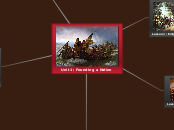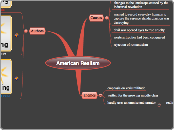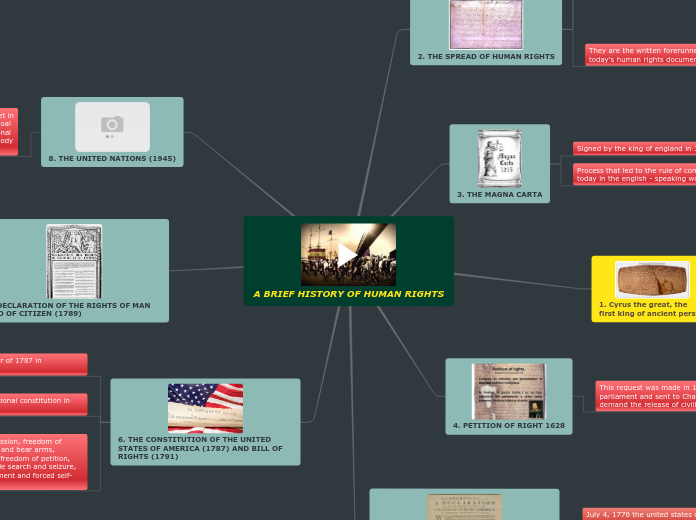Unit 1: Founding a Nation
Lesson 4: Reconstruction
Objective-Students will determine the effectiveness of Reconstruction through a visual and written analysis of primary source documents.
Goal- Students will understand how the effects of the Civil War and policies of Reconstruction shaped the development of the nation, socially/demographically, economically, and politically.
Assessment-Summative: Students will complete an exit slip prior to leaving class, explaining their thoughts on the effectiveness of Reconstruction via the background information provided and their classmates' presentations on primary source documents.
Teacher presents background information in the lesson introduction.
Assessment-Formative: Students will complete a visual, using either a single PowerPoint slide or a Padlet to present a historical document or image to the class.
Teacher organizes students into assigned groups to analyze an assigned primary source document.
Lesson 3: Civil War
Objective- Students will be able to discuss the factors that led to the outbreak and outcome of the Civil War, and show their understanding through the completion of a graphic organizer.
Goal-Students will understand how the effects of the Civil War and policies of Reconstruction shaped the development of the nation, socially/demographically, economically, and politically.
Assessment- Summative:Students complete an exit slip answering the prompt, "According to the documents you have reviewed, what do you believe was the biggest influence in the outbreak of the Civil War, why? What do you believe affected the war's outcome the most, why? Were any of the documents' explanations surprising to you, why?"
Students answer the exit slip prompt.
Assessment- Formative:Students complete a graphic organizer that identifies causes for the outbreak and outcome of the Civil War.
Students complete the organizer.
Assessment- Entry Level: Students complete a brief survey as a class, by holding up an "agree," "disagree," or "unsure" sign.
The teacher makes a series of statements that students must respond to, so the teacher may assess their prior knowledge.
Students answer the survey questions.
Lesson 2: Constitution
Objective-Students will analyze the controversy surrounding the ratification of the Constitution by participating in a mock debate.
Goal- Students will understand the controversy surrounding the ratification and drafting of the Constitution and why it is considered a “living document.”
Assessment- Summative: Students complete an exit slip prior to the end of class, explaining the arguments of Federalists and Anti-Federalists using the phrases, "Federalists defended the ratification of the Constitution because..." and "whereas Anti-Federalists..." at least once in their response.
Students write their response for the exit slip.
Assessment- Formative: Students participate in a classroom debate as an assigned historical figure, representing either a Federalist or Anti-Federalist. They must present and defend their figure's argument in class via a fishbowl style Socratic seminar.
The teacher facilitates the class debate and acts as moderator.
Students research and debate their assigned position.
Assessment- Entry Level: Students complete a short quiz on the Constitution and its ratification. They then brainstorm and review the answers as a class.
The teacher reads and explains answers.
Students complete the quiz.
Lesson 5: Industrialization
Objectives- Students will be able to identify major industries and technological advancements during the industrial revolution and their significance in the US and in establishing the US as a world power with the aid of guided notes.
Goal- Students will be able to connect industrial developments across time, explaining how they came to be, what impact they had on the time period, and how they would ultimately influence future developments.
Assessment- Students will complete a graphic organizer in the form of guided notes, identifying major advances, detailing what they do and why they are important.
Students complete guided notes.
Assessment- Students will answer a series of prompts, which connect the events of the Industrial Revolution to other themes in US history.
Students complete guided notes, and answer prompts. Students discuss answers with partners and with the class.
Teacher gives a lecture on major technological advances during the Industrial Revolution.
Lesson 1: Enlightenment
Objective- Students will be able to identify major themes of the Enlightenment and how they were applied in the formation of the United States.
Goal--Students will appreciate the importance of the Enlightenment in regards to its influence on the Founding Fathers’ political philosophies and as a backdrop to the creation of the United States, the Constitution, and the Bill of Rights.
Assessment- Summative: Students will write a short paper which explains how the themes of the Enlightenment provided the context for the creation of the United States and how those themes shine through in the Declaration of Independence, using evidence from their text and the Declaration of Independence.
Teacher finishes the lesson by asking students about their sentence strip topics and how they relate to the Enlightenment.
Students complete reading and sentence strips.
Assessment- Formative: Students complete a "foldable" of sentence strips that detail how an event, person, and/or document reflect ideas or thinkers of the Enlightenment during the reading. Using the assigned sections of the text, students explore the Enlightenment and the background of events leading up to the American Revolution. Students will create at least six sentence strips to identify a person, event, or document/passage, explain said topic, and connect it to the Enlightenment.
Students complete reading assignment and sentence strips.
The teacher introduces the topic and explains how to assemble the sentence strips.









